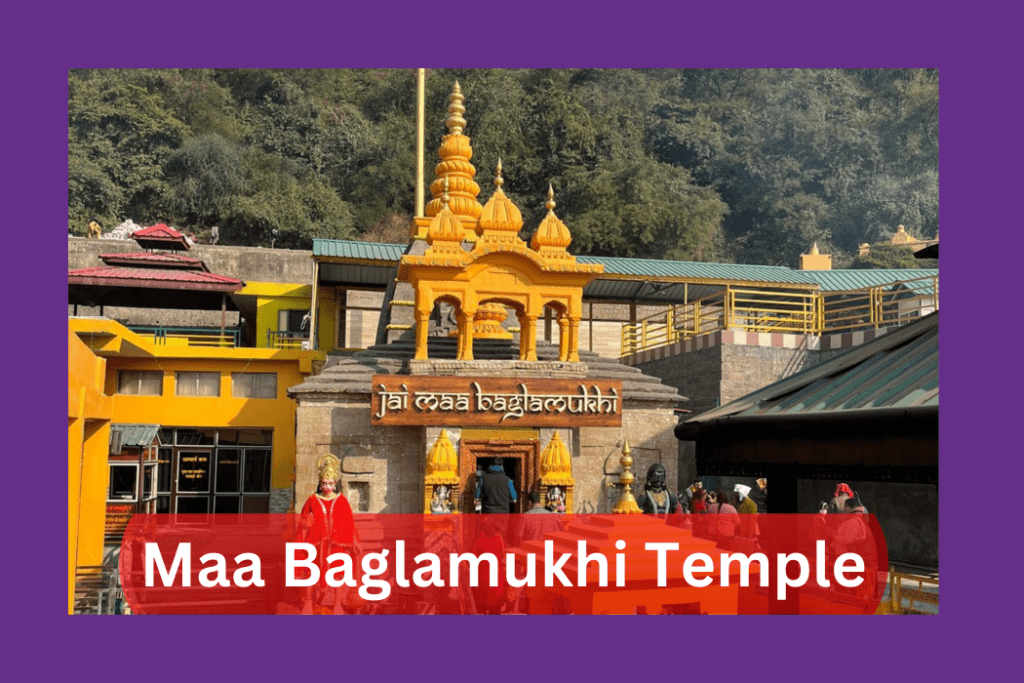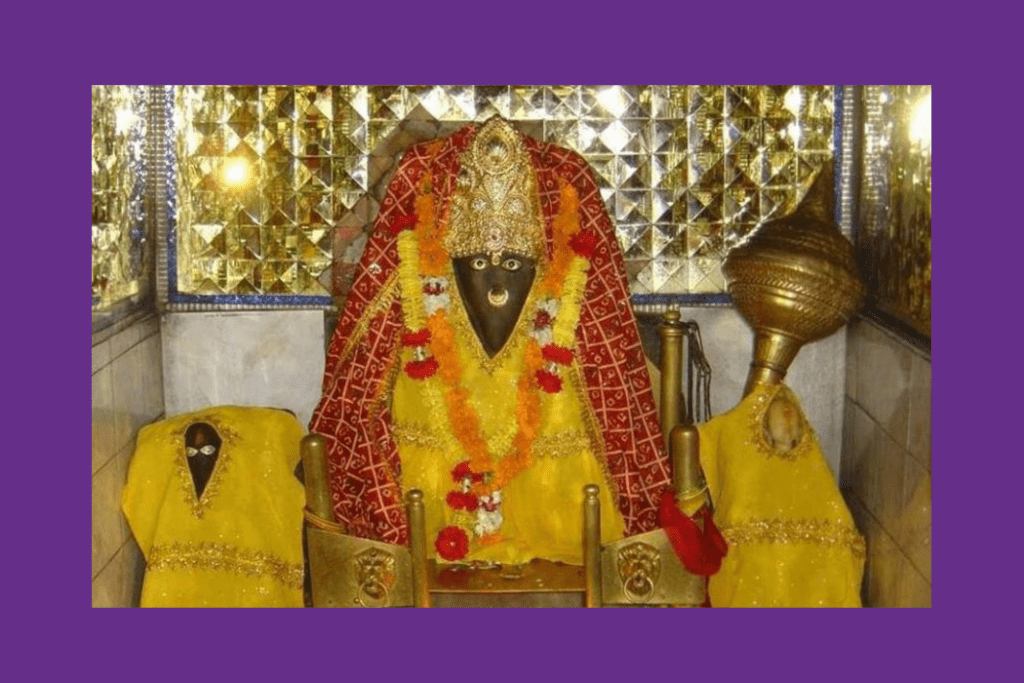Maa Baglamukhi Temple, Kangra- Himachal Pradesh: History, Significance, and Travel
This blog discusses the history, architectural layout, top attractions, and ambiance that make Maa Baglamukhi Temple a great destination.

Located in the Kangra district of Himachal Pradesh and surrounded by the Himalayas, the Bagalamukhi Temple is a hidden treasure waiting to be discovered. This temple stands out from others by being permeated with the strong presence of Maa Baglamukhi, the eighth manifestation of the formidable goddess Durga.
Having difficulties with a court case that seems to have no end? Require additional support to excel in a test? Are you longing for achievement and contentment in life? Followers from all over India come to this temple with hope in their hearts, seeking divine blessings from Maa Baglamukhi.
Legend whispers tales of wishes granted after performing special rituals like yajna within the temple’s sacred walls. This potent belief draws people not just from Himachal Pradesh, but from all corners of the country. Here, in the shadow of the Himalayas, hope finds a powerful voice.
The pleasant shade of yellow can be seen in the sweet besan laddu offerings made to the goddess. The Bagalamukhi Temple goes beyond being just a religious site; it offers a mesmerising encounter combining devotion, customs, and a steadfast trust in the divine’s strength.
Therefore, if you ever need a glimmer of optimism, a location where dreams soar, think about starting a trip to this distinctive Himalayan refuge. Here, surrounded by the stunning splendour of the mountains, you may uncover the enchantment of Maa Baglamukhi.
This blog discusses the history, architectural layout, top attractions, and serene ambiance that make Maa Baglamukhi Temple an ideal destination.
| Participate in online puja organised by VAMA (Get the puja done with your name and gotra) | |
| Name of Puja | Temple (Place) |
| Rin Mukti Puja | Rin Mukteshwar Mahadev Temple (Ujjain) |
| Tantra Badha Mukti Bhairav Mahasuraksha Yagya | Vikrant Bhairav Mandir,Ujjain |
| Shani Sade Sati | Shani Shingnapur Devsthanam ,Maharashtra |
| Vyapar Vriddhi Mahalakshami Puja Evam 108 Kanak Stotra Path | Mahalakshmi Temple,Maharashtra |
| Rahu Grah Shanti Puja | Jarkutinatheshwar Mahadev Temple, Prayagraj |
| Rahu-Ketu Shanti Puja | Rahu Temple, Paithani, Uttarakhand |
Read this Blog to know about Alopi Devi Temple – Alopi Devi Mandir, Prayagraj: History, Significance, and Travel
History and Story Behind Maa Baglamukhi Temple
The Legend of the Bagalamukhi Temple has been told for centuries, whispered from one generation to the next. In ancient times during Satya Yuga, a powerful tempest ravaged the Earth, causing immense chaos. Seeing such devastation, Lord Vishnu, the protector of the universe, felt a deep sense of worry. He sought assistance from the powerful Lord Shiva, who told him to call upon the divine energy of Goddess Shakti.
As per old tales, in the Satya Yuga, a violent storm ravaged the Earth, resulting in extensive destruction. As Lord Vishnu, the protector of the universe, observed this devastation, he felt deeply troubled. He sought guidance from the powerful Lord Shiva and was instructed to call upon the sacred energy of Goddess Shakti.
Motivated by Vishnu’s dedication, a mesmerising form appeared from the depths of the Haridra Sarovar. Maa Baglamukhi, a powerful manifestation of Goddess Shakti, was depicted shining with golden light reflecting from the lake. She calmed the chaotic tempest, bringing balance and peace back to the world.
It is thought that the Pandavas, famous warriors, built the Baglamukhi Temple in one night during their period of exile. Faced with significant challenges, they sought assistance and guidance from Maa Baglamukhi. This act strengthened the temple’s bond with overcoming obstacles and achieving success.

Architecture of Maa Baglamukhi Temple
The temple stands out with its vibrant yellow hue. This is far from being a coincidence! The colour yellow is strongly linked to Maa Bagalamukhi, representing positivity, faith, and resolute perseverance – traits that she grants to her followers.
The architectural style combines various regional influences to create a distinctive look. The feeling of greatness is produced by the dome-shaped roof held up by strong pillars. The architectural style combines various regional influences in a distinctive manner. The grand feeling is produced by the dome-shaped roof upheld by strong pillars.
It is interesting that the temple hosts multiple other deities in addition to Maa Bagalamukhi. Lord Bhairava and Lord Hanuman’s statues protect the main shrine, representing security and steadfast commitment. A Shivlinga is also there, emphasising the interconnected nature of the divine world. Many Hindu temples commonly feature the practice of housing multiple deities.
Talk to Our Astrologers Now!
First Consultation FREE!
Spiritual Significance and Festivals
Navratri: Navratri is a nine-day festival dedicated to honouring different forms of Durga, such as Maa Baglamukhi, and is a period for deep prayer and fasting.
On the eighth day of Navratri, known as Ashtami, devotees honour Maa Baglamukhi with special rituals and offerings.
Homagni: This ritual involves praying and offering specific items to a holy fire, in order to receive blessings from the goddess.
Yajna: A different ceremonial offering, frequently including reciting mantras and offering specific oblations to Maa Baglamukhi.
How to Reach the Maa Baglamukhi Temple?
Gaggal Airport offers convenient air travel to Dharamsala and Kangra. Also referred to as Kangra Airport, it is conveniently situated near both towns.
Situated 8 kilometres away from Kangra.
Located 15 kilometres away from Dharamshala.
The airport provides frequent flights to Delhi, making it a convenient choice for travellers in the area. Even with the existing restriction of approximately 100 passengers, travellers from big cities can still conveniently make connecting flights via Delhi.
While travelling by train to Kangra and Dharamshala may not be the fastest option, flying to Kangra-Gaggal Airport (DHM) is the speediest alternative. Situated only 8 km from Kangra and 15 km from Dharamshala, the airport provides easy access to the area.
While journeying along Ranital Dehra Road, you will encounter Bankhandi village’s temple only 40 kilometres before reaching Kangra. Fortunately, Kangra enjoys superb road links, allowing worshippers to easily access the area. Kangra is linked to nearby towns such as Shimla (150.4 km), Chamba (148.6 km), and McLeod Ganj (48.9 km) by public bus transportation.
The Maa Baglamukhi Temple in Kangra, Himachal Pradesh, is not only a place of worship but also represents a strong tie to history, dedication, and unwavering faith in the supernatural. Located in the grand Himalayas, this distinctive temple provides a safe haven for individuals looking for optimism, resilience, and the sacred favour of Maa Baglamukhi, the eighth manifestation of Goddess Durga.
Frequently Asked Questions
What is the significance of Maa Baglamukhi Temple?
It is interesting that the temple hosts multiple other deities in addition to Maa Bagalamukhi. Lord Bhairava and Lord Hanuman’s statues protect the main shrine, representing security and steadfast commitment. A Shivlinga is also there, emphasising the interconnected nature of the divine world. Many Hindu temples commonly feature the practice of housing multiple deities.
What is the story of Maa Baglamukhi Temple?
As per old tales, in the Satya Yuga, a violent storm ravaged the Earth, resulting in extensive destruction. As Lord Vishnu, the protector of the universe, observed this devastation, he felt deeply troubled. He sought guidance from the powerful Lord Shiva and was instructed to call upon the sacred energy of Goddess Shakti.
How is the Architecture of Maa Baglamukhi Temple?
The temple stands out with its vibrant yellow hue. This is far from being a coincidence! The colour yellow is strongly linked to Maa Bagalamukhi, representing positivity, faith, and resolute perseverance – traits that she grants to her followers. The architectural style combines various regional influences to create a distinctive look. The feeling of greatness is produced by the dome-shaped roof held up by strong pillars.
Want to know about Bhimashankar Jyotirlinga? Read this blog – Bhimashankar Jyotirlinga, Pune: History, Significance, and Travel




